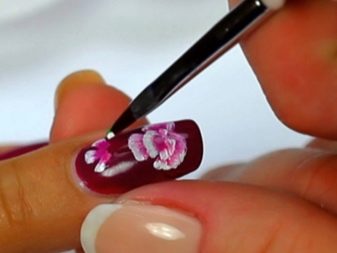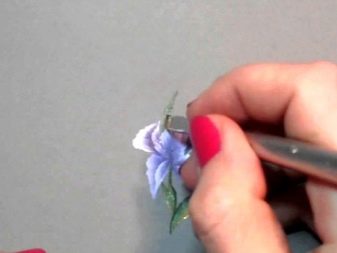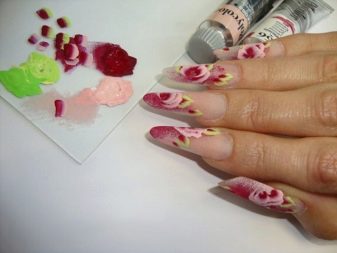Chinese painting on nails: ways to create and useful recommendations

Among the various techniques for covering the nail, Chinese painting stands out. This is a rather difficult, but effective technique, having mastered it, you can learn how to draw three-dimensional, mesmerizing images. With the help of "Chinese" it will also be possible to create hieroglyphs - a very popular nail coating that has a sacred meaning.

Peculiarities
Chinese painting on nails, she is "Chinese", appeared in manicure relatively recently. This technique is a rather complex acrylic painting, which is applied with special flat brushes and looks amazing on both long and short nails. Chinese-style painting refers to volumetric painting. Its essence lies in the fact that with the help of one tool different lines are drawn, which then cross and form graceful patterns. The final picture is three-dimensional, unusual and eye-catching.




As a rule, in the technique, the birthplace of which is China, the work takes place mainly with plant and floral ornaments., and the base of the plate is painted with pastel shades of varnish. Sometimes, of course, there are also bright images made on a black background. Most often, masters depict various flowers on the nails, for example, roses, lilies or daffodils. The outline of the buds is slightly blurred, since the use of clear lines in Chinese painting is not encouraged. However, nail art is often complemented by rhinestones, colored stones, foil, sparkles and other details.




Design types
Working with "Chinese" for beginners starts with an acquaintance with the existing varieties of brush strokes.

Firstly, the technology of satin stitching is widespread - in this case, the brush goes, without coming off, along the same trajectory and forms an even stroke.


Secondly, drawings in the semi-shade technique are popular. To create them, according to the ready-made scheme, rounded small loops are applied, maintaining the same gap between themselves. The brush moves up, then to the side, and then down.


Thirdly, a technique called openwork is used. It requires the use of an uneven edge on the brush, which draws a large loop facing upward. Then the tool begins to move down and up again, and the size of the stroke is gradually reduced.


Fourth, professionals use a stroke called a pen. The brush intermittently moves up and down, constantly rebuilding.


Fifth, there is a wave. To apply such a smear, you will have to constantly twist the brush without tearing it off the nail plate. In other words, it moves up, then sideways, and then down, and vortex motions are obtained.


And finally, sixth, the aqua technique is very popular. It is used to create accents, darken unsuccessful fragments and highlight successful ones, as well as create element transparency. For example, aqua allows you to create lace edging and wave shadows.


If we talk about design solutions, then we should separately mention the Chinese characters, which are often depicted using this technique.


Images with sakura twigs, whales and outlandish non-existent flowers are quite popular. In the latter case, the base of a beige tone is most often chosen, and then the lines that form the buds are drawn in a bright blue or yellow shade.


Execution technique
It will take quite a long time to learn how to master Chinese painting, however, if you follow the instructions step by step, the technology will be mastered. Persistent acrylic paints will be used for manicure, which are made on a water basis using silicone, allowing you to create a three-dimensional image. Such a coating will turn out to be quite durable, so it will eliminate the need to update the manicure every week. For the first time, it is better to use a beige base, but, in general, gradients look good, allowing one shade to smoothly transition into another. In general, the background can be anything.


A special brush with a flat shape is selected. With the help of it, neat lines are applied to the nail plate, the combination of which resembles modeling. The more complex the selected image, the more layers will be required. The creation of a "Chinese" begins with the fact that first a sketch is worked out, and then a kind of nodules are created, the appearance of which is formed depending on the inclination of the brush used and its pressure. If the drawing is planned to be complex, then most often the use of different techniques is required. For example, you can create a memorable background with a sponge.


The base for the image is done using ordinary varnish, ideally matte. The use of acrylic paints is also not prohibited. Use a good quality brush with natural hairs of medium shade. Miniature and graceful elements, as a rule, are drawn with a special liner. If you need to depict grass, then you should prepare a fan-shaped brush, and tools with coarse bristles are suitable for fabrics and textures. To create complex images, it is most convenient to use the usual palette for artists, or mix paints on a piece of foil. In addition, clean water wipes and a fixer are useful.


The creation of a Chinese painting begins with the preparation of the nail plate. It all starts with creating a form, then treating it with an antiseptic and eliminating excess care products. Next, you need to decide on the pattern and pick up paints.If these are flowers, then at least a couple of shades of the same main color are required. The background, leaves and buds should be combined with each other and make up a complete picture.


First of all, the background is painted over with both ordinary varnish and acrylic paints. Only paints are required for the gradient. The plate is painted over with light strokes, and the movements should be non-stop in order to create a single layer without transitions. Finally, the palette contains two paints that will be needed to create the key image. This can be done in two ways.


In the first case, two piles are formed on the palette. A flat brush is dipped with one tip in a light shade, and with the other tip in a dark one. Then, right here, with a brush, it is done over the stroke in different directions so that the colors do not mix. A new, transitional color is formed on the brush in the middle, and it will be possible to work in three shades.


In the second case, two tracks of different colors are drawn on the palette. To work, the brush will need to be placed between them, and then put on the nail plate and rotated around its axis.

Before starting work, it is important to "rehearse" color combinationsso as not to discover that some combinations form a dirty blot instead of a beautiful shade. If nothing goes well, then you can always replace one of the colors with white - it is suitable for almost any design. In addition, it is worth working on paper first. In the event that the layers and loops are obtained on a flat surface, you can transfer them to the nail. Professionals advise not to rush with a manicure and wait for the background to completely solidify, as well as the drawing itself in front of a transparent fixer.


Interesting examples of manicure
To depict a rose on your nails, you first need to cover them with transparent varnish. While the base dries, soft pink and pure white colors are applied to the palette. A wide brush is dipped into the paint with different edges and, having shaded, also creates a transitional version. To form a bud, you need to make one semicircular stroke in the form of an arch, the same in the form of an inverted arch, and another one below for more volume. The stem and leaves are drawn with a green brush. At the last stage, the manicure is covered with a transparent fixative.


Drawing a cornflower begins with the same steps, only instead of pink, blue is applied to the palette. White, by the way, is also needed. One tip of a wide brush is dipped in white, the other in blue, after which they are shaded. The center of the cornflower is indicated in blue, after which this blue side of the brush remains in place, and the other is drawn a petal. The rest of the flower is formed in the same way. If you want to make the image brighter, then the contours can be outlined with black paint on a thin brush. We must not forget about the stamens - they are applied with white paint and placed at the base of the cornflower. The finished manicure is fixed with transparent varnish.


In the event that a girl decides to limit herself to plant motifs in a manicure, she will need rich green and light yellow shades. Having finished shading, you will need to create leaves using a pair of wavy lines. You can draw outlines with a thin liner. The same movements are required to create peonies. First of all, the nails are covered with transparent varnish. Next, the brush is immersed with one side in a rich purple color, and the other in pink. The petals are formed in undulating movements, after which the middle is formed with white paint. If desired, the outline is outlined with a thin black line. The whole process ends with the use of a fixer.


There is also an open flower manicure option. In this case, the brush is covered with red and white paints, and the strokes are applied in such a way that a transitional shade appears.Several large petals are created using wave-like movements, after which another level of the flower is made with smaller petals. Upon completion, the center is highlighted in black, and the finished image is varnished with a fixative.


Finishing the floral theme, it is worth mentioning that daisies on a blue base, pink roses on a black background with white veins, or purple orchids with a pastel base look very good. Another interesting option is when there is one flower for two fingers, that is, a half of a plant is depicted on each marigold. Some craftswomen manage to "stretch" the flower arrangement over all five fingers.



For information on how to perform a simple and quick design of nails in the style of Chinese painting, see the next video.








